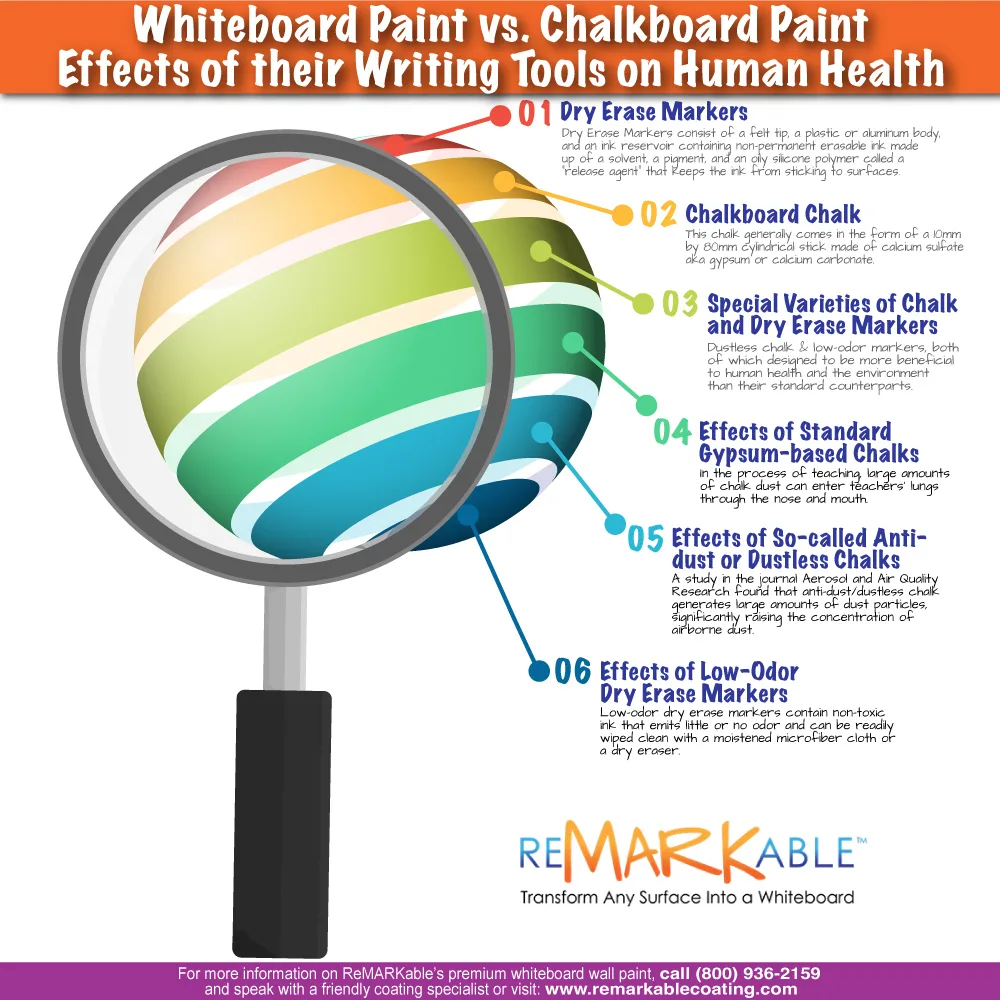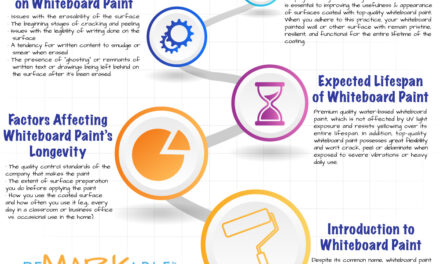Whiteboard Paint vs. Chalkboard Paint: Effects of their Writing Tools on Human Health
Besides having significant differences in the types of writing surfaces they produce, chalkboard paint and whiteboard paint vary greatly with respect to the health effects of their essential writing tools. The chalk used on chalkboard painted walls, and the low-odor dry erase markers used on walls coated with whiteboard paint are poles apart in terms of their impact on a room’s air quality and on users’ health. This article will compare these differences to reveal which of these tools is better for educators and others interested in maintaining optimal wellbeing and a healthy room environment.
Chalkboard Chalk
Chalkboard chalk is a tool that’s applied mainly for writing and drawing on chalkboards but may also be used on other surfaces such as walls, streets, and sidewalks. Chalkboard chalk generally comes in the form of a 10mm by 80mm cylindrical stick made primarily of calcium sulfate aka gypsum (standard chalk) or calcium carbonate (so-called ‘dustless chalk’). Most chalk used today is white, but it can also come in yellow, green, pink, or blue colors.
Dry Erase Markers
Dry-erase markers were patented in 1975 and became popular in the United States throughout the 1990s and beyond as dust-free, cleaner, and healthier alternatives to chalk. They consist of a felt tip, a plastic or aluminum body, and an ink reservoir containing non-permanent erasable ink made up of a solvent, a pigment, and an oily silicone polymer called a “release agent” that keeps the ink from sticking to surfaces.
A dry erase marker’s primary function is to write or draw on slick, non-porous surfaces such as whiteboards and walls coated with whiteboard paint. When used on high-quality writing surfaces like whiteboard painted walls, the chemical makeup of dry erase ink allows it to be easily wiped off by means of a cloth or dry eraser without leaving behind any marks or smudges.
Special Varieties of Chalk and Dry Erase Markers
Both chalkboard chalk and dry erase markers come in special versions – dustless chalk and low-odor markers – designed to be more beneficial to human health and the environment than their standard counterparts. However, this isn’t the case with dustless chalk, as this type of chalk has the same, if not more, harmful effects as standard chalk. On the other hand, low-odor dry erase markers have little or no negative impact on users’ health or the environment. Hence, they offer effective, trouble-free alternatives to standard and dustless chalk.
Health Effects of Chalk
The two types of chalk available today, standard calcium sulfate- or gypsum-based chalk and dustless calcium carbonate-based chalk, are used in countless classrooms and other venues worldwide. The cost of dustless chalks is approximately ten times greater than that of standard chalks. In many developing countries, standard chalk is produced in home-based industries that provide a living for local families.
However, the dust particles produced by standard chalks can affect these families’ health, and they’re also of great concern to educators and healthcare professionals because of their impact on classroom air quality and students’ and teachers’ well-being. Globally, millions of teachers and students are exposed to the hazards of chalk dust every day.
Effects of Standard Gypsum-based Chalks
A recent study from India on the health effects of standard gypsum-based chalk dust found that teachers are the ones who face the greatest health risks posed by chalk in the classroom. In the process of teaching, large amounts of chalk dust can enter teachers’ lungs through the nose and mouth due to these factors:
- their proximity to the chalkboard
- frequent opening of their mouths during lessons
- periodic heavy breathing caused by fatigue or overexertion
- frequent erasure of chalk markings from the chalkboard.
The current state of knowledge about chalk dust suggests that it can stay suspended in the air for some time before settling on the classroom floor, on teachers’ and students’ bodies, and on the equipment and supplies used for lessons.
The Indian study, whose results were published in the journal Indoor and Built Environment, concludes that chalk dust can be harmful to people with allergies, can cause watery eyes and breathing problems, and can create a constant problem in classrooms by soiling clothes, body parts, furniture, and study materials.
Effects of So-called Anti-dust or Dustless Chalks
Another recent study published in the journal Aerosol and Air Quality Research found that just like standard chalk, anti-dust or dustless chalk can generate large amounts of dust particles and thus significantly raise the concentration of airborne dust in the vicinity of a chalkboard.
Approximately 15% of the chalk dust particles observed in the study were respirable, meaning they were extremely fine and could penetrate deep into the lungs, causing potentially severe ailments such as asthma and chronic obstructive pulmonary disease (COPD).
Also, during the study, high concentrations of ultrafine chalk dust degraded the indoor air quality, and chalk was also found to be the primary source of coarse particles. Running the ventilation system re-suspended the chalk dust that had already settled in the room, thus boosting the concentration of airborne particles and further lowering the air quality.
Throughout the study, the use of so-called dustless chalk produced a mixture of coarse, fine, and ultrafine particles, especially when the chalkboard was erased. The best method for reducing the amount of chalk dust permeating the classroom was to open doors and turn on ceiling fans. Wearing face masks and increasing the distance between students’ seats and the chalkboard can also help safeguard teachers and students from chalk dust and improve classroom air quality.
Yet another problem with certain dustless chalk brands is that they contain casein, a protein found in milk. When children with milk allergies inhale chalk dust containing casein, potentially life-threatening asthma attacks and other health problems such as coughing, wheezing, nasal congestion, shortness of breath, sneezing, and runny noses may occur.
Effects of Low-Odor Dry Erase Markers
An easy way to eliminate the above-mentioned dangers of airborne chalk dust is to use eco-friendly, low-odor dry erase markers on a wall coated with high-quality whiteboard paint as an alternative. Low-odor dry erase markers contain non-toxic ink that emits little or no odor and can be readily wiped clean with a moistened microfiber cloth or a dry eraser.
Many educators and other individuals are reluctant to inhale chalk dust and dislike the fumes from standard “high-odor” dry erase markers. The ink in these markers contains a petroleum-based solvent called xylene, which has an unpleasant smell and may cause irritation of the skin, eyes, nose, and throat. By contrast, low-odor dry erase markers are 100% free of xylene and thus lack a disagreeable smell and the related negative health effects.
Xylene, which the European Union classifies as a “harmful” substance, can be inhaled or absorbed through the skin, and poisoning with xylene can lead to severe illness. In the short term, xylene poisoning can damage the central nervous system, create breathing problems, and cause nausea. It can also trigger vomiting, as well as headaches and dizziness that could lead to a loss of consciousness. Long-term xylene exposure only makes these problems worse. For these reasons, manufacturers of quality low-odor dry erase markers avoid using xylene as a solvent when formulating their inks.
Instead, low-odor dry erase markers contain specially formulated, eco-friendly inks that include solvents like ethanol and isopropyl alcohol, making them virtually odor-free and safe for users’ health and the environment. That’s why the choice is clear after you compare the negative effects of using chalk on a chalkboard painted wall and the benefits of using low-odor dry erase wall markers on a whiteboard painted wall.


























































































![ReMARKable’s Winter Sale is Here! [25% Off + Free Shipping]](https://www.remarkablecoating.com/wp-content/uploads/2018/01/Red-Tag-Winter-Fashion-Facebook-Post-1-440x264.png)















![Drive Your Organization Into Openness and Watch it Expand [20% Off Whiteboard Paint]](https://www.remarkablecoating.com/wp-content/uploads/2016/04/Drive-Your-Organization-Into-Openness-and-Watch-It-Expand.-1-440x264.jpg)

![30% Off St Patrick’s Day Sale! [Details Inside]](https://www.remarkablecoating.com/wp-content/uploads/2016/03/Glorious-1-440x264.png)


![Giant Leaps Forward Require Big Spaces. [Leap Year Sale Event!]](https://www.remarkablecoating.com/wp-content/uploads/2016/02/Giant-Leaps-ForwardRequire-Big-Spaces-440x264.jpg)

















![ReMARKable Summer Sale 2018 [28% Off Whiteboard Paint]](https://www.remarkablecoating.com/wp-content/uploads/2018/06/Blue-Simple-Line-Beach-Facebook-Post-1-440x264.png)




































































































































































































0 Comments